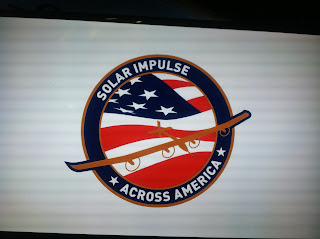Saturday, July 13, 2013
Comment du Jour
Dragon Fly in JFK Hangar
Solar Impulse
Dragonfly Wings Across America
A dragonfly-like aircraft, large but seemingly fragile, slow but silent, and powered by sunlight, has flown safely across America. The amazing and indeed epic coast to coast journey by the Swiss engineered and piloted Solar Impulse plane concluded in New York setting a number of aeronautical records for exclusively solar powered flight.
Swiss aviation pioneers Dr. Bertrand Piccard and Andre Borschberg remain the founders, pilots and the driving force behind the world’s first aircraft which can fly day and night without traditional fuels. The amazing carbon fiber aircraft has the wingspan of a Boeing 747 (63 m or 208 feet) but the weight of a small car (1,600kg or 3,500 lbs).
Inside an aircraft hangar at JFK airport, the plane resembles a huge dragon fly or the iconic U 2 recon plane; a large wing and a pencil-thin fuselage. Indeed 12,000 solar cells are built into the wings to power four 10 horsepower electric propellers with renewable energy.
Arriving at New York’s JFK on a hot summer night, the aircraft set a new aviation milestone; the first trans-continental flight from San Francisco to New York without using a drop of fossil fuel.
Pioneer Pilots Bertrand Piccard (left) and Andre Borschberg
“Yesterday we had a dream, but today it has come true,” stated an ecstatic Bertrand Piccard, “ it is a miracle.”
Indeed beyond the actual flight Solar Impluse has developed new technologies and new materials. And the cost? According to Andre Borschberg, while the project is “a catalyst for new technology” the actual price was about $130 million or half the cost of a Hollywood blockbuster film such as Avatar.
The Solar Impulse
Starting in San Francisco, California in early May with a majestic sweep over the Golden Gate Bridge, the plane piloted by Piccard, first flew to Phoenix, Arizona. Later in the May the plane flew to Dallas, then in early June to St. Louis. In mid-June the aircraft flew to Washington DC/Dulles airport.
In early July with Andre Borschberg at the controls, the plane made its final flight leg from Washington to New York. The distance covered was 495 kms or 267 miles; the flight time 18 hours and 23 minutes. Why so long? Slow speed and complicated air traffic control patterns on the east coast. As the cockpit holds only one person each pilot alternated in flying the plane on different legs of the trip.
Andre Borschberg briefs French Air Force Officer
Viewing the evolution of solar powered aviation, Borschberg suggested “You should see this like being in 1915 when the aviation pioneers were trying to do these first cross-country flights, but still unable to cross the ocean…but it’s an important step for the development of aviation.”
The single-seat plane flies with a painstakingly slow average speed of 70 kms per hour; the plane is powered entirely by solar cells. Now that the cross-country journey is successfully completed, the aircraft shall be disassembled and shipped back to Switzerland.
Solar Impulse is a pioneering prototype aircraft, what is likely the first step in a long research and development phase which according to the team is “fueled by dreams, driven by passion.”
French Consul General Bertrand Lortholary
Philosophically speaking, the plane evokes many images. French Consul-General Bertrand Lortholary opined that standing alongside the Solar Impulse recalls the historic moment when the American Consul in Paris would help greet the Spirit of St. Louis and the arrival of Charles Lindbergh after his historic transatlantic flight in 1927. Viewing the arrival of the Solar Impulse the Consul added, “Dreams are not Illusions.”
Subscribe to:
Post Comments (Atom)







No comments:
Post a Comment